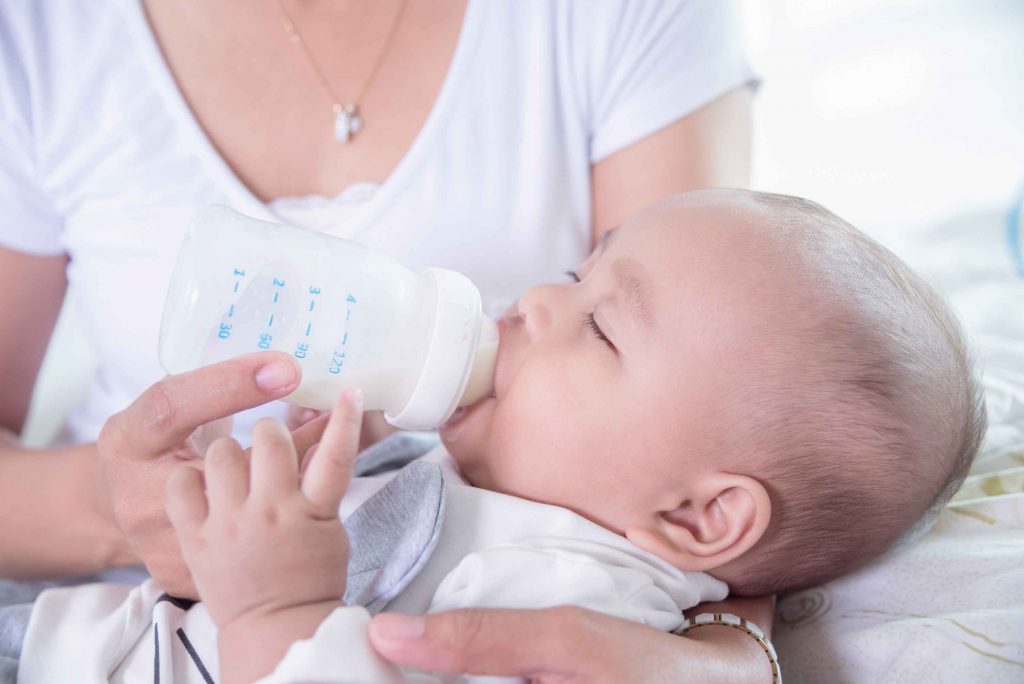If you are transitioning your baby to feeding from a bottle, you may want to try pace feeding. Pace feeding is also an excellent solution if your baby is overfeeding. Since pace feeding involves holding the baby upright, it gives them more control over eating as much as they need by controlling the flow.
However, if you have started pace feeding, you may wonder now at what age do you stop pace feeding. Pace feeding is a similar way to breastfeeding while minimizing over-eating and ensuring better digestion.

What Age Do You Stop Pace Feeding?
You should pace-feed your baby at least until they reach six months or when you introduce solids to their diet. Pace feeding will allow your baby to have more control over the food intake and be able to stop when they feel full. Overfeeding can lead to digestive issues like colic.
When Can You Be Done With Pace Feeding?
Paced bottle feeding is a technique that aids in controlling a baby’s eating rate. This frequently entails a slower tempo that allows your child to take breaks as necessary. Paced bottle feeding reduces overeating and helps your baby recognize their powerful internal hunger and fullness cues.
Babies frequently increase their consumption to 6-8 ounces between four and six months. This amount often stays constant until solid foods are introduced, after which intake may decline. When your baby is around six months old, you will start introducing solids into their diet, so you can gradually stop pace feeding.
Consider the possibility that your infant is receiving excessive amounts of milk at a feeding if your baby appears uncomfortable after feeding.
These symptoms can include excessive fussiness, pain while sleeping on the back, copious quantities of spitting up, and abdominal tightness while sobbing, possibly indicating excessive gassiness or colic.
Why is pace feeding better for the baby?
If you want to avoid your infant experiencing any digestive issues due to overfeeding, it is best to pace-feed them. With pace feeding, you give your baby control over their feeding, meaning they will be able to stop eating when they feel full.
The baby will need to suck on their own to get the food out of the bottle, which will teach them about their safety when eating. Also, when the baby feels full, they stop eating and refuse the bottle.
How to Pace Feed Your Baby
In order to finish a bottle, try to pace the feeding such that it takes 15-20 minutes. After being fed in this manner, some babies may automatically begin to pace themselves, which is the goal of pace feeding.
If you are unsure how to start pace-feeding your baby, follow the next steps.
Read more: How To Keep A Baby Awake During Feeding

How to pace feed step-by-step
- Hold your baby with the head in line with their spine and body slightly reclined so that the baby’s head is not turned and the baby is not resting with the chin on their shoulder.
- Use a bottle that has a nipple with a slow flow. Wide base nipples, according to some mothers, assist in preventing nipple confusion.
- Gently, so that the baby controls when the feed starts, draw the nipple into the baby’s mouth rather than forcing it there.
- Make sure the bottle is horizontal and slightly vertical so that milk stays in the nipple.
- Allow your baby to take 3–4 milk suckings.
- Carefully take the baby’s bottle nipple out of their mouth and place it at their lips.
- Listen to your infant to determine when they are ready for the nipple back.
- Give the baby another 2-3 sucks before the subsequent pause. Continue until the baby is done nursing.
- Let your baby decide when they want to stop eating.
Benefits of Pace Feeding
Pace feeding has many benefits, so many parents are starting to do it for their babies. Some of the benefits are the following.
Avoid overfeeding your baby
The infant may not receive the proper amount of milk if the parent is the one who decides when and how much to feed them. Paced bottle feeding helps the baby take control like the child does while nursing. This allows the baby to stop eating once they feel full instead of overeating.
No distress during feeding time
When a baby is placed on their back to drink from a bottle, they can get highly distressed. If a baby drinks milk from a bottle, additional milk is forced out of the bottle by negative pressure. To prevent choking, the baby needs to keep gulping. Baby is given the time and space to eat at their own pace when the feeding is pace-fed.
Prevent colic
Using the right feeding methods and a high-quality bottle can reduce symptoms similar to colic. When milk flows into a baby’s mouth from a traditional bottle, the infant gulps to keep up and may swallow air, which may result in gas. Colic can be incredibly uncomfortable for your baby and painful, leading to excessive crying.
The Length of Pace Feeding Sessions
If your child can finish a bottle in 5 to 10 minutes, the milk is probably flowing too quickly, and your baby might not be able to recognize when they are full. The flow can be excessively slow if the feeding takes more than 30 minutes.
A bottle-fed baby should get fed for around the same amount of time as a breastfed baby, about 15 to 20 minutes for every meal.
Keep in mind that practicing timed feeding can help you, your baby, and anyone else who may be helping you in feeding your child.
Also read: How to Teach a Baby to Drink From a Straw
Conclusion
In conclusion, parents who practice pace feeding do so to ensure their babies are getting as much food as they need and avoid overfeeding. If you want to pace-feed your baby, you likely also want to know at what age do you stop pace feeding.
As I mentioned, a good cutoff period is around six months, as that is when you will start introducing solids into your child’s diet.








